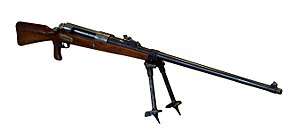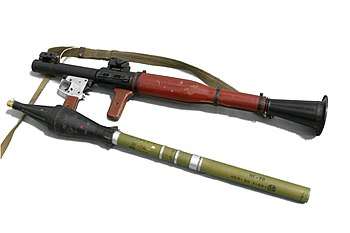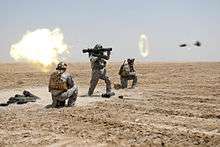Man-portable anti-tank systems
Man-portable anti-tank systems (MANPATS or MPATS) are shoulder-launched anti-tank rockets. They are typically unguided weapons and are a threat to armored vehicles, low-flying aircraft (especially helicopters), and field fortifications. Generally, MANPATS fall into three distinct categories. The first consist of a small, disposable preloaded launch tube firing a high explosive anti-tank warhead operated by a single soldier. The second is a firing system onto/into which a rocket is loaded, operated by a single soldier. The third are manufactured prepacked and issued as a single unit of ammunition with the launcher discarded after a single use.
Modern MANPATS have their roots in the 20th century with the early development of the explosive shaped charge.[1] The development of practical rocketry provided a means of delivering such an explosive. Research occasioned by World War II produced such weapons as the German Panzerfaust followed by the American bazooka which combined portability with effectiveness against armored vehicles, fortifications and buildings.
Anti-tank rifles

Arguably, the first MANPATS could be Anti-tank rifles developed during World War I. An anti-tank rifle is a rifle designed to penetrate the armour of vehicles, particularly tanks. The usefulness of rifles for this purpose ran from the introduction of tanks in World War I and until the Korean War. While medium and heavy tank armour became too thick to be penetrated by rigid projectiles from rifles that could be carried by a single soldier, anti-tank rifles continued to be used against other targets. Anti-materiel rifles of today, such as the Barrett M82, are a development of the Second World War technology. Although no longer capable of penetrating even the side armour of the main battle tanks, they are capable of causing serious damage to their external fittings such as periscopes and machine guns, and in disabling or even destroying less well armoured and support vehicles, helicopters, low-flying UAVs and personnel.
Bazooka

Bazooka is the common name for a man-portable, tube launched, recoilless rocket antitank weapon, widely fielded by the United States Army. Also referred to as the "Stovepipe", the innovative bazooka was amongst the first generation of rocket propelled anti-tank weapons used in infantry combat. Featuring a solid rocket motor for propulsion, it allowed for high-explosive anti-tank (HEAT) warheads to be delivered against armored vehicles, machine gun nests, and fortified bunkers at ranges beyond that of a standard thrown grenade or mine. The Bazooka also fired a HESH, effective against buildings and tank armour. The universally-applied nickname arose from the M1 variant's vague resemblance to the musical instrument called a "bazooka" invented and popularized by 1930s U.S. comedian Bob Burns.
Rocket-propelled grenade

A rocket-propelled grenade (often abbreviated RPG) is a shoulder-fired, anti-tank weapon system that fires rockets equipped with an explosive warhead. These warheads are affixed to a rocket motor and stabilized in flight with fins. Some types of RPG are reloadable, while others are single-use. RPGs, with the exception of self-contained versions, are loaded from the muzzle.[2] RPGs are very effective against armored vehicles such as armoured personnel carriers (APCs). The Soviet RPG-7 is the most widely distributed and used RPG in the world.[3] Its basic design was developed by the Soviets shortly after World War II in the form of the RPG-2, which did not itself use rockets – RPG is the Russian abbreviation for Ruchnoy Protivotankovy Granatomyot, which translates as "hand-held antitank grenade launcher".
Recoilless rifles

A recoilless rifle (RR) or recoilless gun is a type of lightweight artillery system or man-portable launcher that is designed to eject some form of countermass, such as propellant gas, from the rear of the weapon at the moment of firing, creating forward thrust that counteracts most of the weapon's recoil. Technically, only devices that use a rifled barrel are recoilless rifles. Smoothbore variants are recoilless guns. This distinction is often lost, and both are often called recoilless rifles.[4] Though similar in appearance to a rocket launcher, a recoilless weapon fires shells that use conventional gun propellant. The key difference from rocket launchers (whether man-portable or not) is that the projectile of the recoilless rifle is initially launched using conventional explosive propellant rather than a rocket motor. While there are rocket-assisted rounds for recoilless launchers, they are still ejected from the barrel by the detonation of an initial explosive propelling charge.
Anti-tank missile
An anti-tank missile (ATM), anti-tank guided missile (ATGM), anti-tank guided weapon (ATGW) or anti-armor guided weapon is a guided missile primarily designed to hit and destroy heavily armored military vehicles. ATGMs range in size from shoulder-launched weapons, which can be transported by a single soldier, to larger tripod-mounted weapons, which require a squad or team to transport and fire, to vehicle and aircraft mounted missile systems. The introduction of smaller, man-portable ATGMs, such as the Dragon and Javelin, with larger warheads to the modern battlefield has given infantry the ability to defeat light and medium tanks at great ranges, though main battle tanks using composite and reactive armors have proven to be resistant to smaller ATGMs.[5][6] Earlier infantry anti-tank weapons, such as anti-tank rifles, anti-tank missiles and magnetic anti-tank mines, had limited armor-penetration abilities and/or required a soldier to approach the target closely. See: List of anti-tank missiles.
Notes
- Shaped Charge
- Peter E. Kaiser (2001). Jarold E. Brown (ed.). "Rocket+Propelled+Grenade"+muzzle-load#v=onepage&q&f=false Historical dictionary of the U.S. Army. ISBN 978-0-313-29322-1. Retrieved 24 January 2011.
- Rocket Propelled Grenades Archived 2014-04-12 at the Wayback Machine about.com
- Julio S.. Las Armas Modernas de Infantería, Abril de 1953
- "T-90 tank". Archived from the original on 2008-01-29. Retrieved 2008-01-29. is tested against ATGMs.
- British tank sustains damage overseas.
Bibliography
- "Infantry Anti-Tank Weapons", Bayonet strength, 150m, archived from the original on 2008-07-31.
- "Grenades through RPGs", Weaponology (programme), Military Channel, 2008-11-18.